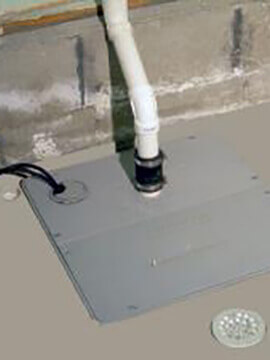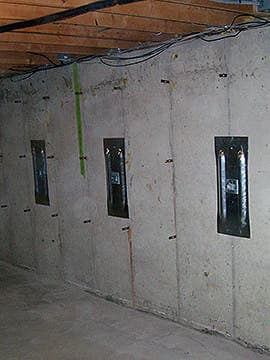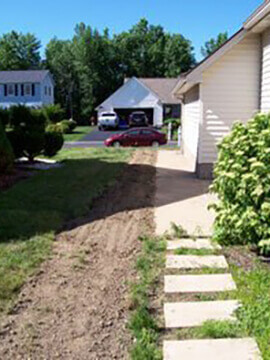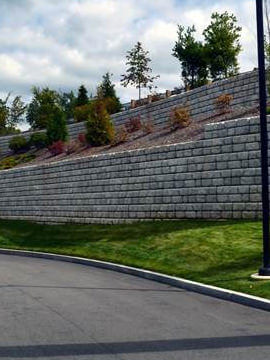Foundation Repair Questions
Field Stone Foundations: 5 Best Fixes
Field stone foundations are foundations made with rocks pushed into the dirt. Mud and crude "mortar" mix is pushed in between the rocks.
The 5 Best Fixes for a Fieldstone Foundation
1. Dehumidifiers
Purchasing a high-demand dehumidifier, like a Santa Fe Classic or April Aire, will decrease the humidity in your basement, stop mold and mildew growth, and give longevity to the 100+ year-old wood.
2. Skim Coat the basement
A skim coating is the application of a morter/concrete type mixture by a mason that is slopped on the basement walls to hold the orginal mortar/mud in place. A new skim coatings last 5 to 10 years. A mason can also try to put rocks back that have fallen into the basement.
3. Gutters
All the water from the roof should go into the gutters. Go outside and look up when it's raining. Then again when it's raining hard. What you should look for:
- Wet or black spots under gutters (Means gutter is overflowing)
- Water overflowing gutters
- Water bypassing gutters on inside corners
- Small pieces of gutter that have a large area of roof that feed to it.
- Upper gutters from dormers or upper roofs that feed directly into the gutter below
How to fix the gutter problems:
- Have gutters cleaned 2x per year on a schedule
- Get wider gutters
- Get gutter guards that stick up out of the gutter to force the water down into the gutter.
- Re-configure gutters or add more
4. Downspouts
All the water from the gutters should be discharged at least 5 feet away from the foundation
All the water from the gutters should be discharged at least 5 feet away from the foundation
- Downspouts that go into the ground into a storm system: Every 3-5 years, storm lines should be snaked and camera-ed by a plumber. Testing your gutter storm system with garden hose cannot match mother nature. Call a professional. A cracked, clogged, or broken pipe can overflow water directly at the downspout connection or underground. These can be abandoned if necessary.
- Downspouts that go out on the grass: Discharge through a solid pipe a minimum of 5' away from the foundation, assuming the dirt is sloped away from the house. If the grading is off or there is a hill, discharge has to be farther. DO NOT DISCHARGE DOWNSPOUTS INTO FLOWER BEDS! The water will lay beside the foundation causing water in the basement, or worse, foundation cracks and failure.
5. Grading
All dirt around a house should be 5" higher then the dirt 5' away from the house or higher. There should be a visible slope, having the water move away from the foundation. Mulch in flower beds does not count. Remove the mulch to measure where the actual dirt is. Removal of flower garden and bushes may be necessary. Be sure to increase the grade under decks.
Make sure sidewalks, driveways, and patios are "tipped" away from the foundation. Repairing grading and hard services is much cheaper compared to foundation repair AND fixing those things.
NEVER DIG UP THE FOUNDATION!
The rocks were just pushed into the dirt and removing that has a high probability of them falling in. Replacing a fieldstone foundation is much more costly than replacing modern block walls. The entire wall will need to be removed down to the bottom. A trench will need to be dug to make a footer and the blocks then stacked. As the "good parts" of the wall are exposed on the outside, rocks will continue to fall in, make the wall replacement bigger and bigger. Taking more time will be butting square blocks up to round rocks.
Work very hard at the above 5 items and you will give longevity to your fieldstone foundation and save tens of thousands of dollars.
Minor to Major:
Measure Bowing: put a level against the wall. If you need something longer, use a broom handle or something else straight in conjunction. Measure the distance from the sill plate (wood at the top of the wall) to your stick when level. Sometimes the bottom is pushing in, sometimes the wall is bowing in, and sometimes the top or bottom is being pushed in but the wall looks like it's bowing out.
Hair Line Crack: The crack is only in mortar lines is only a few feet long. It doesn't extend to the floor or ceiling. It's not big enough to put a pen in. There is no bowing of the wall.
Minor Cracks: Hair line cracks in conjunction with "larger" ones. Some you can put a pen in. Extend to floor or across wall. Bowing less than 1".
Major Cracks: Hair line, minor, and cracks fingers can fit into or bowing is greater than 2". Some walls will bow "evenly" and there will be many cracks while others will have 1 gaping crack.
NEVER COVER A CRACK WITHOUT STABILIZING THE WALL 1ST! Crack injections or covering the crack can stop the water from coming in or hide the crack, if that is your concern, but they are just a band-aid. The injection will "pop" or the crack will open when the foundation moves again with the changing soil conditions. If water or moisture coming through the crack is your concern, work on gutters, downspouts, and grading. We never recommend digging on the outside because this will aerate the soil, allowing more water to the area. Covering a crack hides the home's gutter or grading problem on the outside allowing accumulation of water to worsen outside and put more pressure on the wall.
Cracks from because of water pushing from the outside with heavy rain/freezing and/or loss of hydrostatic pressure when there is a drought.
If the cracks are newly found and are hairline cracks, try to find the "water culprit" on the outside. Look for things like: patio's tipped toward the home, downspout removed/overflowing, gutter overflowing or water sheeting off the roof, etc. Mark the ends of the cracks with chalk/lead pencil, take measurements, and lots of pictures. If you are able to fix the afore mentioned water problems and over the next few months/year the cracks do not worsen, you don't need to do anything! If nothing can be found, hopefully it was a 1 time event, but it could be the soil conditions and how the water moves toward your house. If they worsen, a foundation repair solution will need to be installed.
Minor and Major cracks should be taken seriously and the wall should be stabilized because the structural integrity of the wall has been lost. Even if a known water problem on the outside has been fixed, it may slow down the movement of the wall, but it will continue to move, crack, and worsen. As the cracks worsen, it costs more and more money to fix. Wall Anchors are used to stablize and straighten cracked and bowing walls and are the only foundation repair solution recommended by HUD and the Army Corp of Engineers. If the wall is savable, Wall Anchors are cheaper than a wall rebuild and are guaranteed, where a wall rebuild is not. If the wall is not stablized with Wall Anchors, the wall will worsen and a rebuild will be required. If a wall rebuild is not done in time, the corners of the foundation will start to fail and are much more costly to rebuild than just the wall. Minor to major cracking will cause more and more movement and repair on the 1st and 2nd floors.
All dirt around a house should be 5" higher then the dirt 5' away from the house or higher. There should be a visible slope, having the water move away from the foundation. Mulch in flower beds does not count. Remove the mulch to measure where the actual dirt is. Removal of flower garden and bushes may be necessary. Be sure to increase the grade under decks.
Make sure sidewalks, driveways, and patios are "tipped" away from the foundation. Repairing grading and hard services is much cheaper compared to foundation repair AND fixing those things.
NEVER DIG UP THE FOUNDATION!
The rocks were just pushed into the dirt and removing that has a high probability of them falling in. Replacing a fieldstone foundation is much more costly than replacing modern block walls. The entire wall will need to be removed down to the bottom. A trench will need to be dug to make a footer and the blocks then stacked. As the "good parts" of the wall are exposed on the outside, rocks will continue to fall in, make the wall replacement bigger and bigger. Taking more time will be butting square blocks up to round rocks.
Work very hard at the above 5 items and you will give longevity to your fieldstone foundation and save tens of thousands of dollars.
Is A Crack In A Foundation Wall A Bad Thing: Yes, But How Bad?
A crack in a foundation wall is ALWAYS a cause for concern, "doing something about it" has varying options.
Minor to Major:
Measure Bowing: put a level against the wall. If you need something longer, use a broom handle or something else straight in conjunction. Measure the distance from the sill plate (wood at the top of the wall) to your stick when level. Sometimes the bottom is pushing in, sometimes the wall is bowing in, and sometimes the top or bottom is being pushed in but the wall looks like it's bowing out.
Hair Line Crack: The crack is only in mortar lines is only a few feet long. It doesn't extend to the floor or ceiling. It's not big enough to put a pen in. There is no bowing of the wall.
Minor Cracks: Hair line cracks in conjunction with "larger" ones. Some you can put a pen in. Extend to floor or across wall. Bowing less than 1".
Major Cracks: Hair line, minor, and cracks fingers can fit into or bowing is greater than 2". Some walls will bow "evenly" and there will be many cracks while others will have 1 gaping crack.
NEVER COVER A CRACK WITHOUT STABILIZING THE WALL 1ST! Crack injections or covering the crack can stop the water from coming in or hide the crack, if that is your concern, but they are just a band-aid. The injection will "pop" or the crack will open when the foundation moves again with the changing soil conditions. If water or moisture coming through the crack is your concern, work on gutters, downspouts, and grading. We never recommend digging on the outside because this will aerate the soil, allowing more water to the area. Covering a crack hides the home's gutter or grading problem on the outside allowing accumulation of water to worsen outside and put more pressure on the wall.
Cracks from because of water pushing from the outside with heavy rain/freezing and/or loss of hydrostatic pressure when there is a drought.
If the cracks are newly found and are hairline cracks, try to find the "water culprit" on the outside. Look for things like: patio's tipped toward the home, downspout removed/overflowing, gutter overflowing or water sheeting off the roof, etc. Mark the ends of the cracks with chalk/lead pencil, take measurements, and lots of pictures. If you are able to fix the afore mentioned water problems and over the next few months/year the cracks do not worsen, you don't need to do anything! If nothing can be found, hopefully it was a 1 time event, but it could be the soil conditions and how the water moves toward your house. If they worsen, a foundation repair solution will need to be installed.
Minor and Major cracks should be taken seriously and the wall should be stabilized because the structural integrity of the wall has been lost. Even if a known water problem on the outside has been fixed, it may slow down the movement of the wall, but it will continue to move, crack, and worsen. As the cracks worsen, it costs more and more money to fix. Wall Anchors are used to stablize and straighten cracked and bowing walls and are the only foundation repair solution recommended by HUD and the Army Corp of Engineers. If the wall is savable, Wall Anchors are cheaper than a wall rebuild and are guaranteed, where a wall rebuild is not. If the wall is not stablized with Wall Anchors, the wall will worsen and a rebuild will be required. If a wall rebuild is not done in time, the corners of the foundation will start to fail and are much more costly to rebuild than just the wall. Minor to major cracking will cause more and more movement and repair on the 1st and 2nd floors.
Call Basement Technologies of WNY, Inc to discuss your options if you have more than hairline cracks. The sooner you stabilize the walls, the more money you will save. (585)-872-9077













